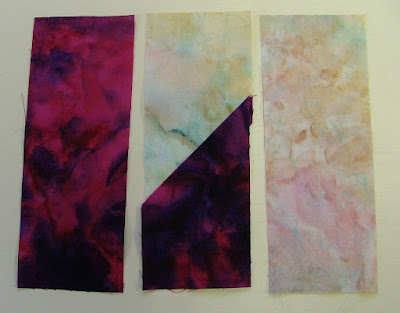BLOG 289
WHIRLIGIG QUILT continued
The building blocks for the quilt need to be cut as a set of strips as follows: 4
at 2 ½” x 6 ½” and 4 at 2 ½” x 4 ½” from one fabric. From a fabric cut from the bolt, you should get 2 sets from
a long quarter metre which is what I was aiming for. Iron the fabric first so
that the selveages are lined up and then straighten the long edge which is at
right angles to the selveage. Remove the scantest of strips from the selveage.
Cut two 2 ½” strips from the long edge. Cut along these strips to give 2 sets.
(Remember that the fabric is doubled and you should be able to do 2 x 6 ½” cuts
the 2 x 4 ½” cuts.)
It has now been incorporated into the quilt-in-progress and
extended. Nothing has been joined together yet; they are stuck in sequence on
my design wall.
The best thing to do is to prepare many sets of fabric. Mine
are divided into light or bright/dark whirligigs. What you always have to
remember with this quilt is that there are 4 different fabrics at the corner of
each whirligig. I am joining my sets together 2 or 3 at a time and placing them
back onto the design wall.
Quilt in progress
In order to develop the quilt it helps to have some idea of
what fabrics are going to be used where so to that end I am pinning sets where
I hope to sew them.
What could help with fabric placement is a printout of the
pattern so you can understand the colour sequence. I am just feeling my way through this quilt.
Looking at what I have done so far, I think I need to add
another row to the right hand side, to complete the prominent red, gold and
blue shapes. I love what I have done to date; it’s very jolly and colourful
which suits me fine!
Aside: I have set up my Husqvarna
machine in my studio to sew this quilt and I have found that the foot pedal is
light and it annoyingly slips on the floor tiles. To solve this problem I have
placed a non-slip mat underneath the foot pedal and it has stabilised the
pedal.








































